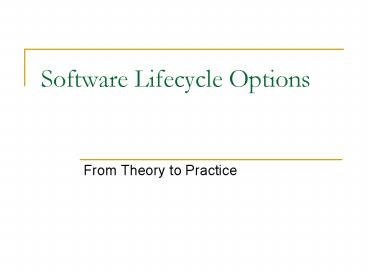Software Lifecycle Options - PowerPoint PPT Presentation
1 / 16
Title:
Software Lifecycle Options
Description:
Software Lifecycle Options From Theory to Practice Goals Understand the drawbacks of the Waterfall Model in practice Understand the Spiral Model as an alternative to ... – PowerPoint PPT presentation
Number of Views:99
Avg rating:3.0/5.0
Title: Software Lifecycle Options
1
Software Lifecycle Options
- From Theory to Practice
2
Goals
- Understand the drawbacks of the Waterfall Model
in practice - Understand the Spiral Model as an alternative to
the Waterfall Model - Understand the phases of the Spiral Model
- Understand how Software Inspection works
3
The Waterfall Model
Adapted from The Engineering of Software by
Hamlet Maybee (2001)
4
More on Modeling
- The Waterfall Model provides a convenient
delineation of software phases, with clear,
distinct boundaries. - Unfortunately, though the Waterfall Model
organizes phases well in theory, the development
process in practice is very rarely as ordered. - Other models lend themselves more to the actual
practice of development ...
5
Other Models of the Lifecycle
- Exploratory Programming
- Good for small problems
- Good for problems that are not well-defined
- Usually seen as a sub-component of the Spiral
Model - Spiral Model
- Developed by the same person as the Waterfall
Model - Based on risk
- Goal is to develop intermediate products
(prototypes) that can be tested to see if it is
worth pursuing the product line any further. - Product can be abandoned at any time (minimal
loss)
6
The Spiral Model
Coding
Design
Testing
START
Requirements/Specification
Adapted from The Engineering of Software by
Hamlet Maybee (2001)
7
Balancing Theory Practice
- The Waterfall Model should be seen as a goal to
attain, with each of its distinct phases in mind. - In practice, the Spiral Model might fit better.
- Regardless, Hamlet and Maybee (2001) identify two
important, sometimes competing, pressures on the
process - Keeping out-of-phase activities to a minimum.
- Tracking solid ideas, even if they dont fit in
the current phase.
8
Requirements/Specification
- Requirements
- Documentation of user requirements
- INPUT User comments and needs
- PRODUCT Document for both internal use and the
user - Specification
- Difficult sometimes to distinguish from
Requirements - More precise statement of the what of the
application - Avoid describing the how
- INPUT The Requirements documentation features
added that need no user input - PRODUCT A document to be used by code designers
9
Design
- Two Phases
- Architecture High Level design that
identifies subsystems, how subsystems communicate
with one another and how each subsystem is
mapped to individual requirements (listed in
the Specification) - Detailed design Low Level design that
deconstructs each subsystem similar to algorithm - Hamlet Maybee (2001) report that a good Design
Document should be detailed enough that coders
will be able to code and test a subsystem without
understanding how that subsystem fits outside it. - INPUTS The Specification Document
- PRODUCT Design Document for use by coders.
10
Coding
- Most of the work should be done in the design
phase. - Inverse relationship
- More work in the Design Phase Shorter time
spent on coding - Poor work in the Design Phase Much longer time
spent on coding - Code Re-use
- Finding larger modules that can be re-used
throughout the application is time-saving - Possible Hurdles
- Documenting exactly what the module does
- Understanding how the module will fit in the
larger picture Will it work properly with the
rest of the product?
11
Coding (continued)
- INPUTS The Design Document
- OUTPUTS Individual application modules that can
be tested.
12
Testing
- Most of the work should be done before the phase
begins creating of a testing document. - Two types of testing
- Testing for errors
- Quality/Usability testing
13
Software Reviews
- Document authors are poor critics of their own
work - Should be done at the end of each phase
- Types of Reviews
- Walkthrough Less formal Document author takes
a listener on a verbal tour (Hamlet Maybee,
2001) through the document. - Inspection More formal process
14
Software Inspection
- Finds many problems normally uncovered in testing
preemptively. - Requires a large investment upfront
- The Software Inspection team
- Author answers questions about the product.
- Moderator keeps the discussion on track.
- Recorder documents all problems uncovered in
detail At the end of the discussion, creates an
Inspection Report with the moderator. - Inspectors raise questions about the product
Must seek to ask questions and not suggest
immediate solutions. - Goal of Inspections To uncover errors, NOT to
suggest immediate solutions.
15
Resources
- Hamlet, Dick and Joe Maybee. The Engineering of
Software Technical Foundations for the
Individual. Boston Addison Wesley Longman, Inc.,
2001.
16
Questions?































